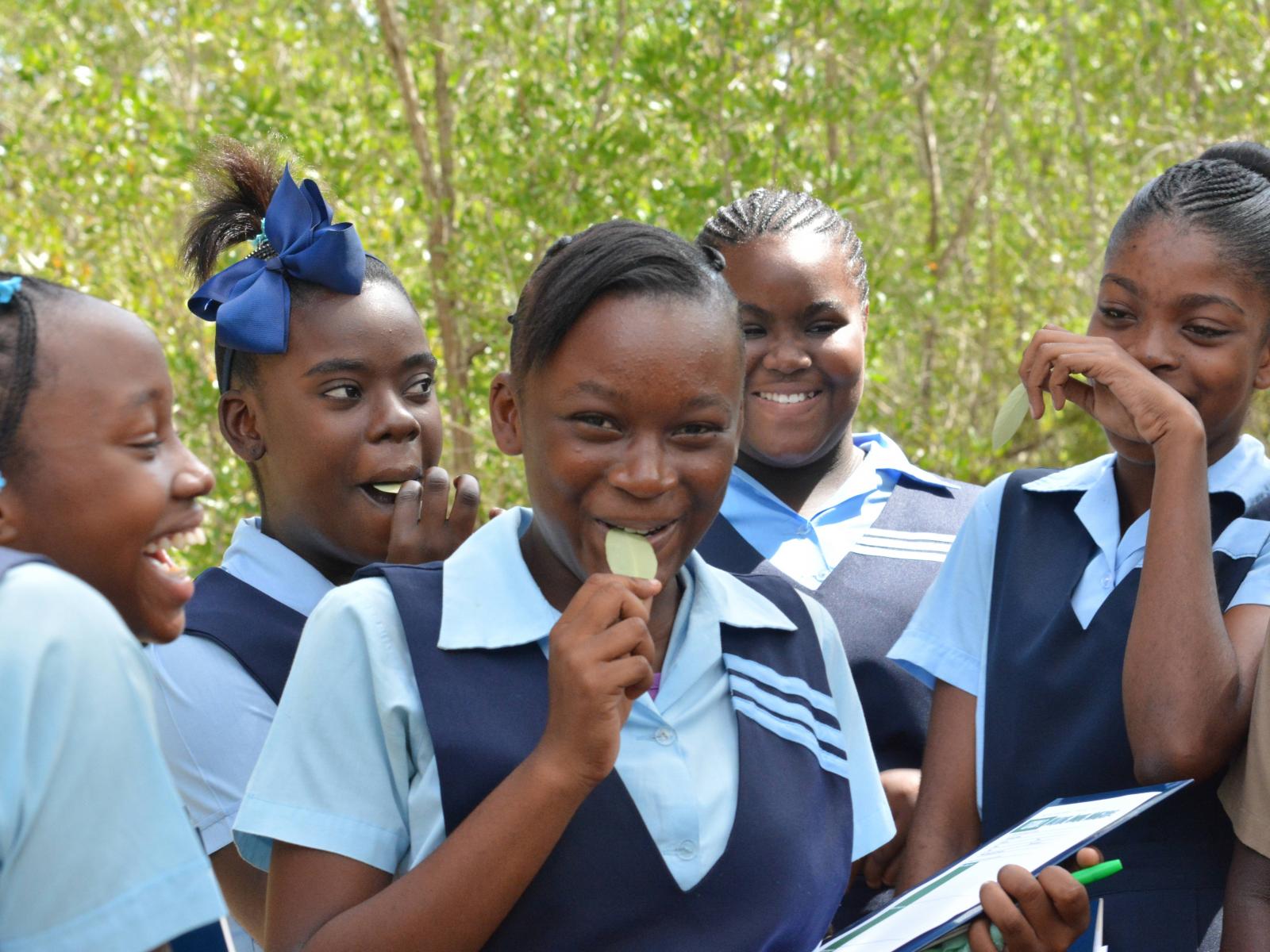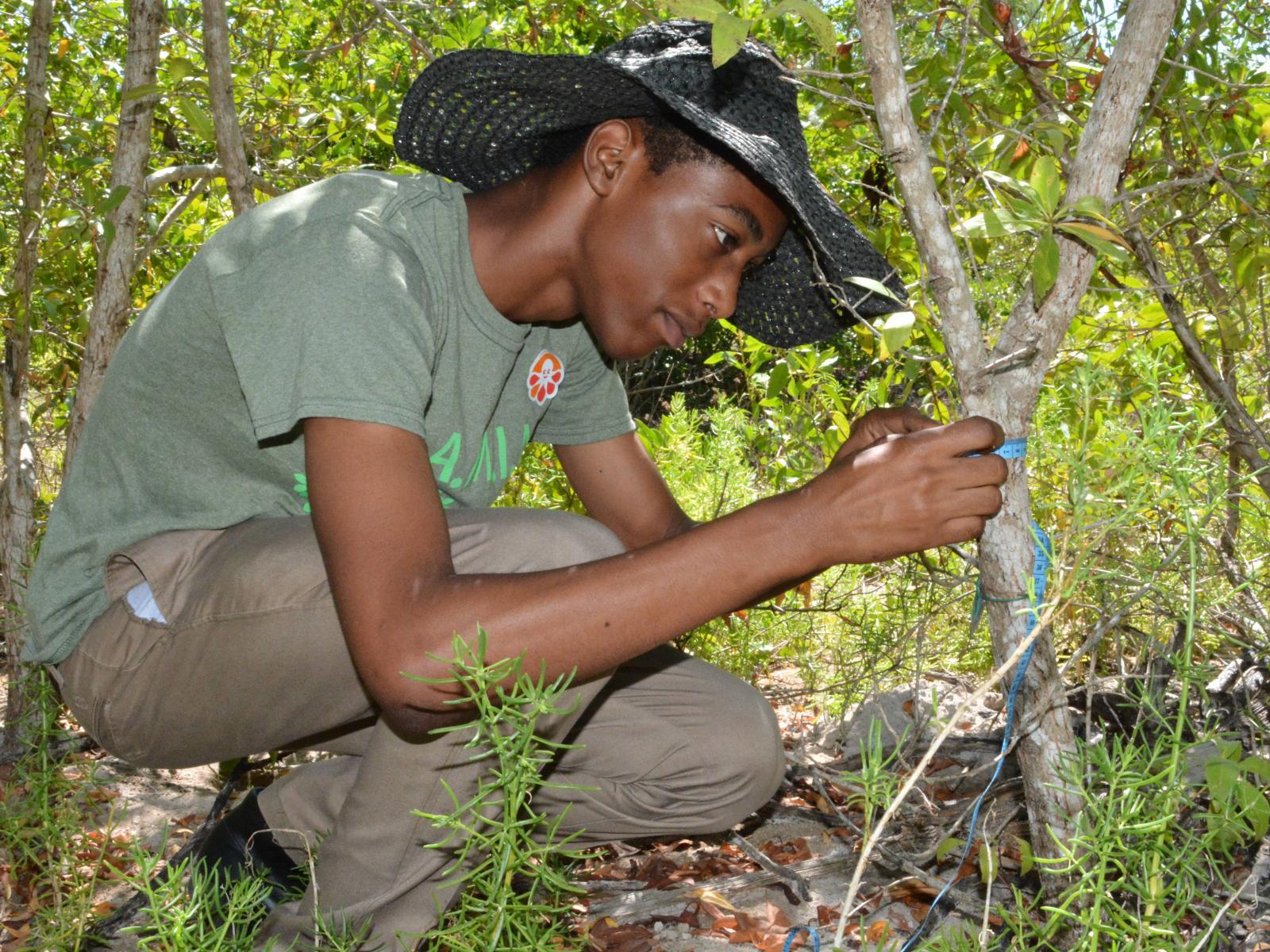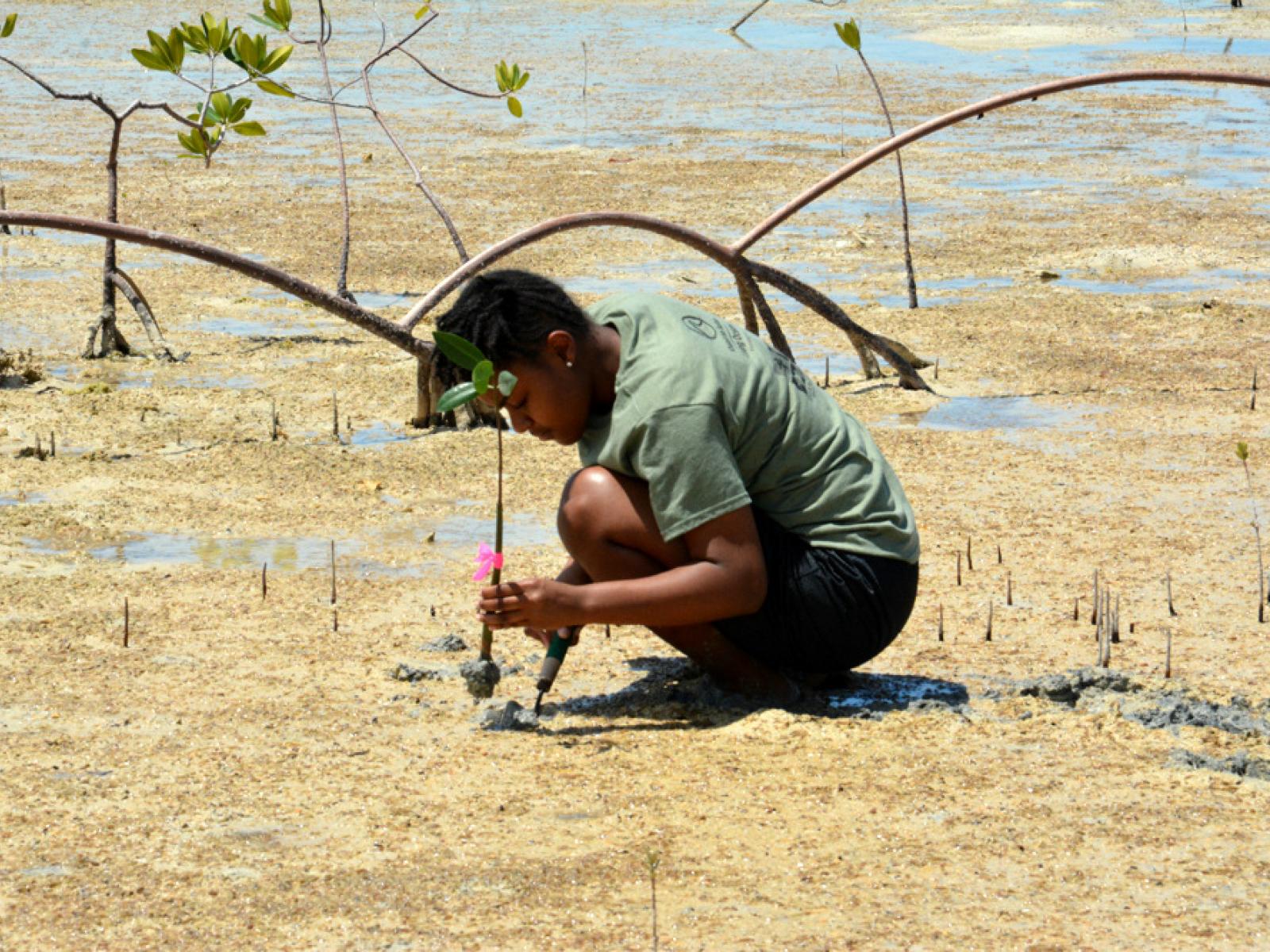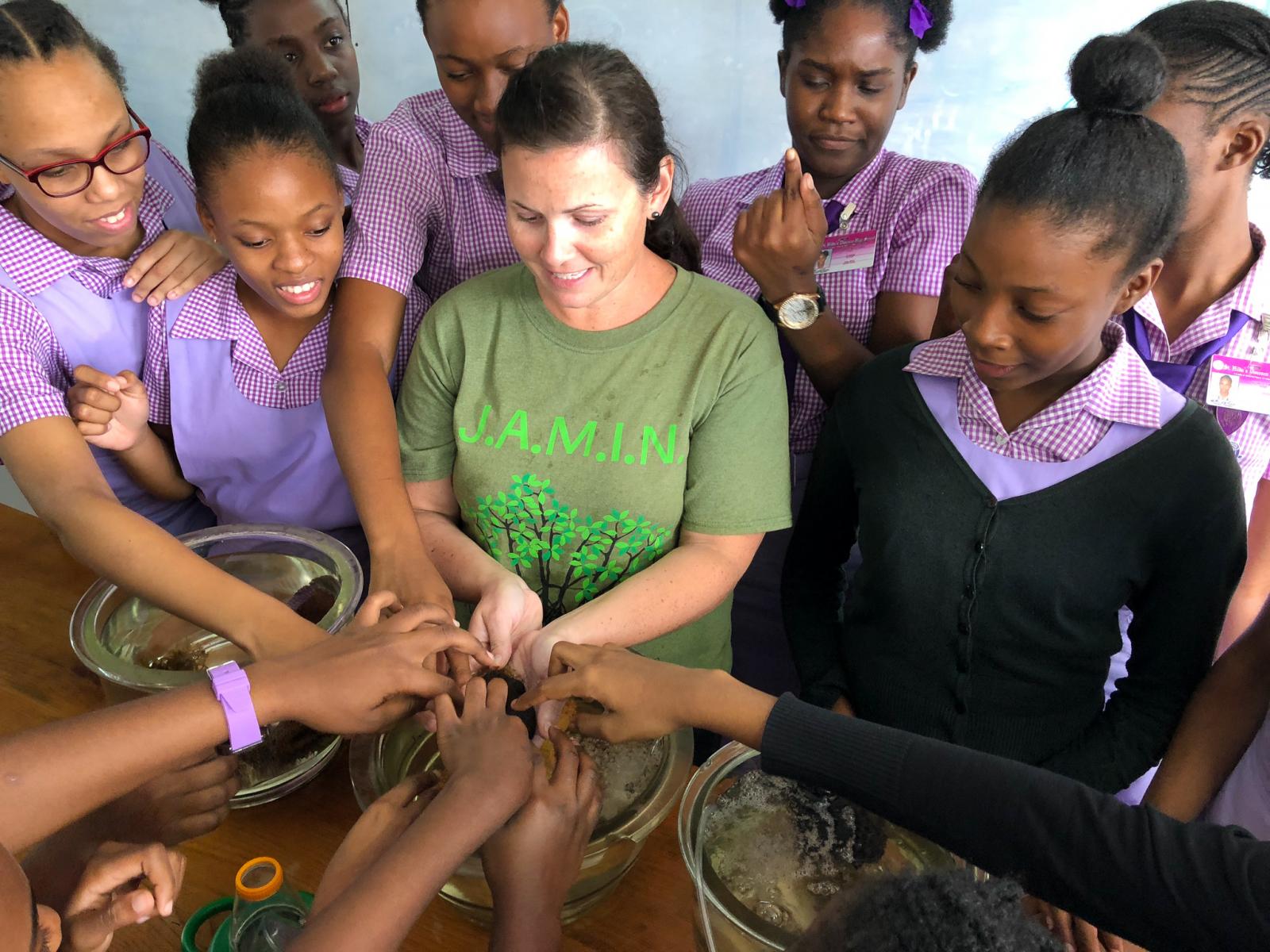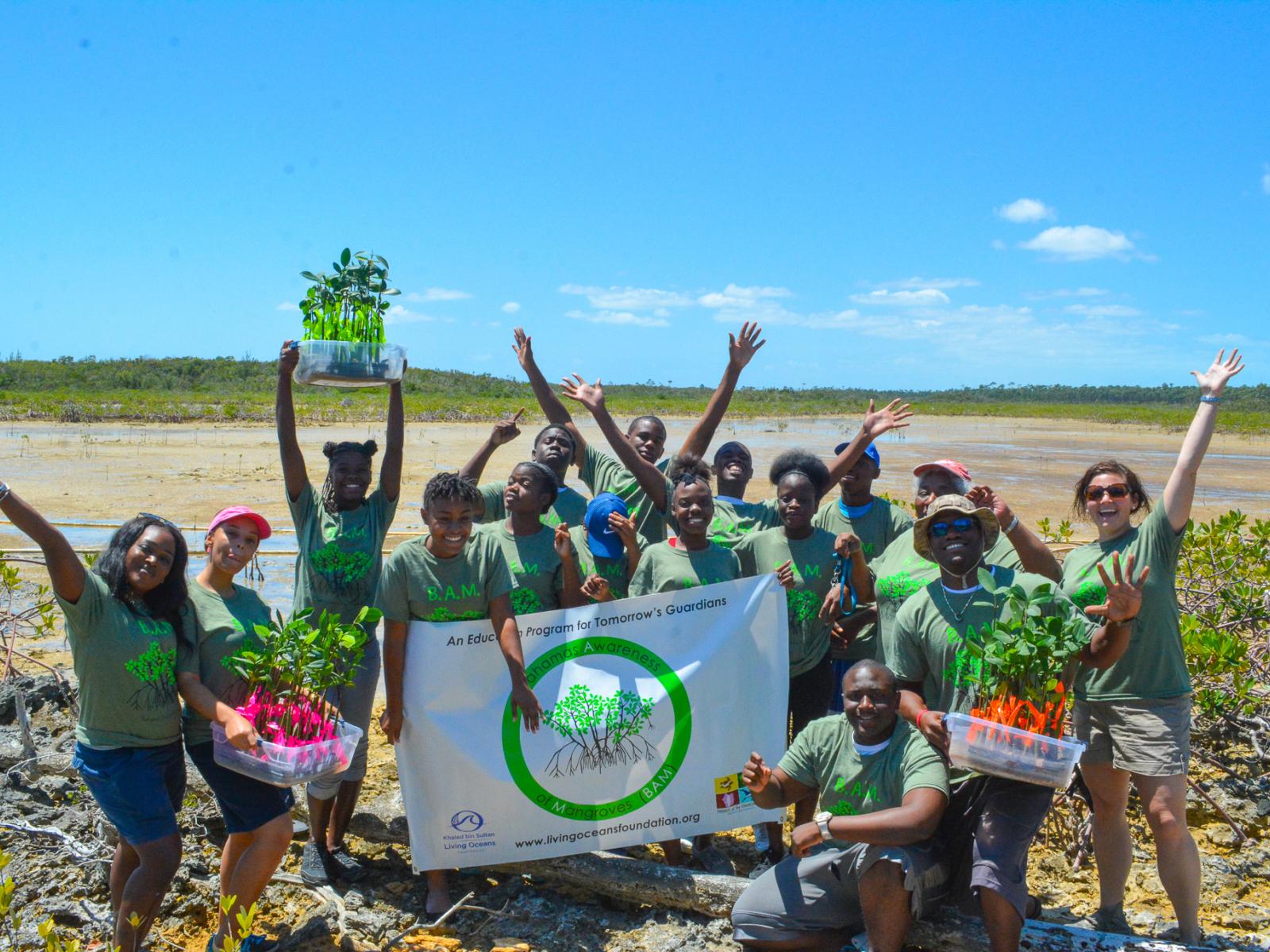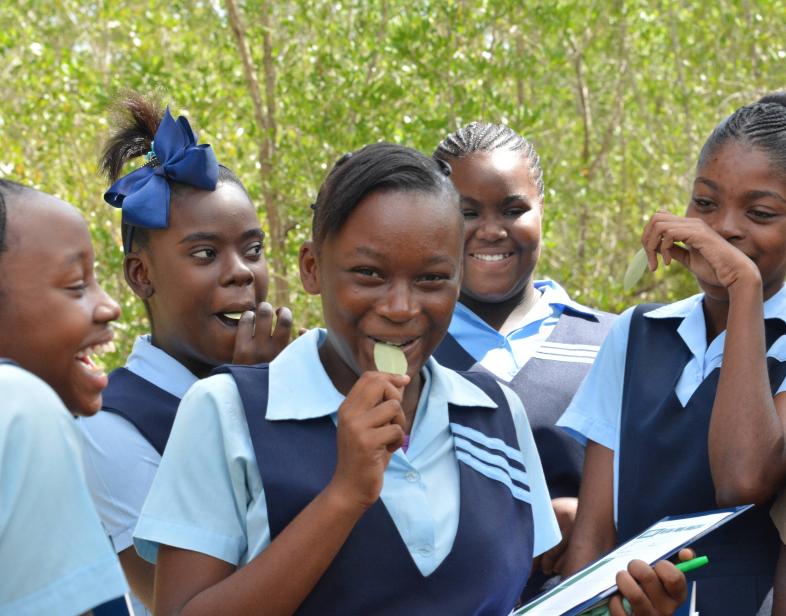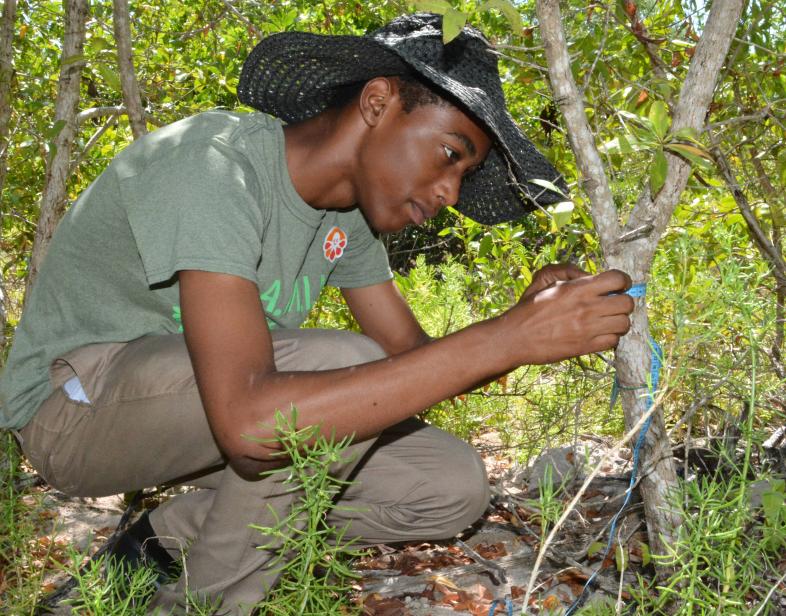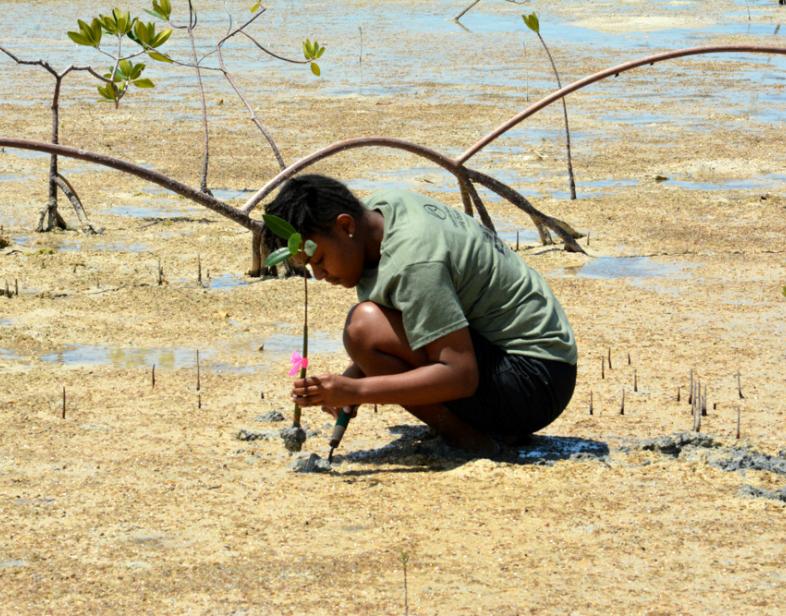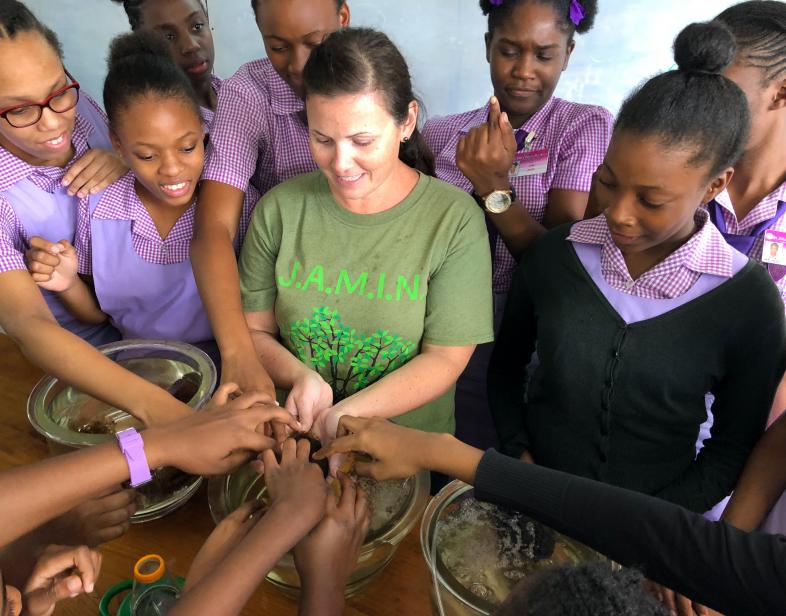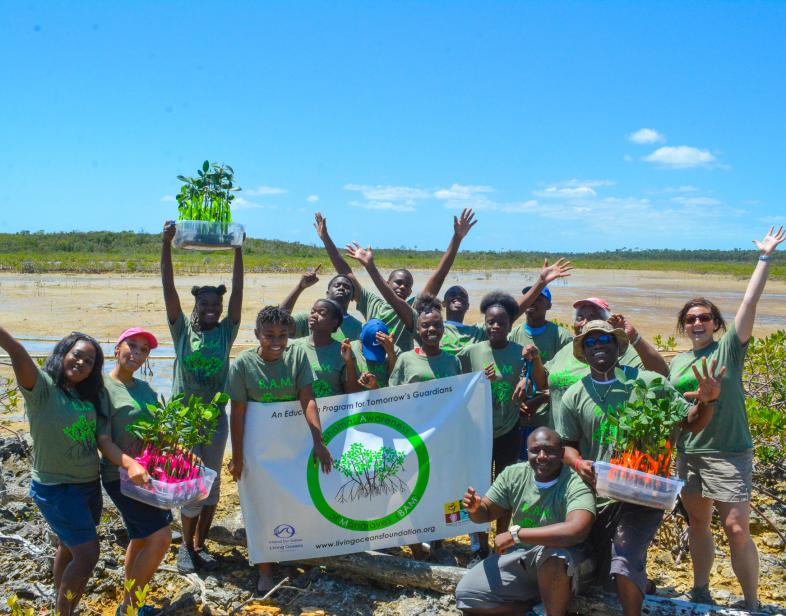An Overview Of Our Solution
Mangrove forests are critically important ecosystems that provide many benefits to people and the environment, including improving water quality by removing sediment, excess nutrients, and toxins from the water. Unfortunately, mangrove forests are disappearing around the world.
To combat the decline of mangrove forests—nature’s water filtration system—the Khaled bin Sultan Living Oceans Foundation runs a Mangrove Education and Restoration Program in The Bahamas and Jamaica. This program works with students and teachers to restore their local mangrove forest.
Students grow mangrove seedlings in their classroom over the school year while learning about the forest, then plant them, helping to restore the ecosystem. The following year, students monitor the trees and water quality in the forest and participate in a citizen science program on mangrove disease.
- Population Impacted: : This program has educated over 800 high school students, who helped to restore mangrove forests in Jamaica and The Bahamas, impacting over nearly 40,000 people who live in these coastal communities.
- Continent: North America
Nombre
Apellidos
Tipo de Organización
Correo electrónico
Análisis de Contexto
Mangrove forests are critical marine ecosystems that protect coastal communities from storms, prevent coastal erosion, provide essential breeding and nursery habitat for fish people rely on for food and income, and also improve water quality. They have an incredible filtration system that removes sediment, excess nutrients, and toxins out of the water. This improvement in water quality not only benefits people, but it also supports nearby ecosystems such as coral reefs and seagrass beds, which depend on clean, clear water to survive.
Unfortunately, mangrove forests are disappearing around the world, felled for coastal development, aquaculture, or wood. It is estimated that more than one-third of the world’s mangrove forests have been lost in the last 50 years.
Our Mangrove Education and Restoration Program helps restore mangrove forests while providing disadvantaged students with an opportunity to learn outside, gain practical scientific experience, and develop a conservation ethic.
Describa la solución técnica que usted esperaba ser adoptada por su audiencia meta.
The Khaled bin Sultan Living Oceans Foundation is working with students and teachers to restore the mangrove forest by growing, planting, and monitoring mangrove trees.
Over the course of the school year, students grow mangrove propagules in their classrooms while they learn about life in the mangrove forests. Then, we take the students into the forest to plant their mangrove trees, helping to restore the forest. In the second year of the program, students return to the mangroves to monitor the forest, looking at growth rate, water quality, and for signs of disease or insect damage.
Through this program, we are helping to restore mangrove forests in The Bahamas and Jamaica while providing students with a quality hands-on science education and inspiring the next generation of ocean advocates to protect this critically important marine ecosystem.
Describa su intervención para cambiar el comportamiento de su audiencia meta relevante a su solución.
The goals of our program are to improve the mangrove forest through education and to impart a conservation ethic. We do this by working with high school students to restore the forest. Teachers are excited to implement the program because they have few resources to teach science. Our program provides teachers with meaningful STEAM activities to use in their classroom while adhering to education standards. They receive our custom-designed curriculum, which includes lectures, videos, teaching guides, and lesson plans.
We employ both information and emotional appeals to create behavior change. Our extensive two-year program provides students with an in-depth learning experience. Research shows that long-term projects help students to acquire deeper knowledge about a subject area. Over the course of two years, students will learn about the basic ecology of mangroves using a combination of lectures, reinforcement activities, field experience, and two long-term scientific investigations (eight months each). During the first year, students conduct a mangrove growth experiment. They grow and monitor their mangroves, and plant them at the end of their experiment. In the 2nd year of the program, students set up quadrats to monitor the forest and investigate mangrove disease. Students collect and analyze data during their investigations and then draw conclusions from it. Over time, students and teachers can see the positive change they make to the forest and to their coastal community.
Palancas de cambio de comportamiento utilizadas
Si es necesario, por favor explique el tipo de intervención en mayor detalle
The in-depth educational experience that we provide allows us to also tap into the emotional connection that students experience during the program. Students rear mangrove seedlings over the course of eight months. When the students plant their mangroves, they find it difficult to part with them because they have a sense of ownership and responsibility for them. After planting them, they have a great sense of pride because they understand that they are a part of a restoration effort that benefits their community in many ways. After this first year of the program, students are extremely interested in protecting the mangroves and they are more confident in conducting the second-year scientific experiment. The students set up quadrats and monitor parameters such as mangrove growth and water quality. They continue to take great ownership of their community’s mangroves when conducting this investigation. Student testimonials can be found here: www.lof.org/jamin-student-voice-2019/.
Describa la implementación de su estrategia y solución.
Our program utilizes proven educational methodologies. We use project-based learning, which allows students to explore real-world problems and acquire deeper knowledge over extended periods of time; and we use place-based learning taking students out of their traditional classroom setting and into their local mangroves. The program lasts for two years with 10th and 11th grade students. Each year the students participate in yearlong scientific investigations.
To ensure success, we implement the program with local partners. We measure success by surveying students over the duration of the program. Several factors are evaluated, including the knowledge attained and retention of information, attitudes towards mangroves and attitude changes, effectiveness of program, and any change in action. Additionally, best practices and lessons learned are established through formal and informal evaluation.
Surveys reveal that students gain knowledge about mangroves, especially increasing their comprehension of the threats posed and benefits of mangroves, and their own environmental impact. This in-depth scientific understanding, combined with the emotions acquired from nurturing and protecting mangroves, often changes attitudes and behaviors not only towards mangroves, but the greater environment.
The key to program success is teacher buy in. The program activities are aligned to each country’s curriculum. Teachers are provided with professional developments to help them to integrate the activities into their regular classes, so that it doesn’t take additional time out of their already pressing schedule.
The main obstacle is having enough time to fulfill all activities with the students. Teachers already have a full teaching schedule. Sometimes it is difficult to get enough time to conduct the program activities. This problem was easily solved once the program had been piloted. Our partners carry out any additional activities that are not completed while we are present.
Describa quién lidera la implementación de su solución.
Our education staff and local partners lead the implementation of the program. All in-country partners have expertise in researching and educating students about marine ecosystems. In Jamaica, we work with the University of the West Indies (UWI) and Alligator Head Foundation (AHF), an environmental NGO. We work with an environmental education NGO, Friends of the Environment (FRIENDS) in Abaco, The Bahamas. Local expertise is essential to implementing the program. We rely on our partners for a variety of functions such as providing scientific and cultural knowledge, liaising with local schools, and implementing activities. As we expand the program, we plan to set up a train-the-trainers program, so our partners can work with teachers to run the program on their own. For more about the program: http://bit.ly/BAMProgram
Incluya algunos de los actores clave con los que colaboró durante el desarrollo e implementación de su proyecto.
High school students and teachers in Jamaica and The Bahamas are the primary stakeholders involved in the program; however, evaluation reveals that students share knowledge about mangroves and our program with their family and friends.
In addition to our key partners (UWI, AHF, and FRIENDS), we work with other organizations that enhance our program. We partner with EarthEcho to provide teachers and students in our program with the opportunity to participate in the EarthEcho Water Challenge. Our students collect water quality data as part of their mangrove research and habitat restoration and contribute their findings to EarthEcho’s global database. In Jamaica, we work with Seville Heritage Park, a cultural historic site. Students in our program restore and monitor the mangroves in the park. We also work with Dr. Ryann Rossi to implement citizen science in our program. Students in our program investigate the presence of mangrove disease and samples are shared with Dr. Ryann Rossi for further genetic testing.
In collaboration with AHF, we received funding to provide professional development training in Jamaica, which will allow us to expose additional stakeholders to the program and train additional teachers. For the first time, we will also be training student teachers and outreach officers from the Jamaican Fisheries Sanctuaries Network.
¿Quién adopto los comportamientos deseados y en qué grado? Por favor incluya evidencia recolectada demostrando el cambio
Since 2014, we had over 800 students participate in our program. Our evaluation plan encompasses both qualitative and quantitative evaluation. Data shows that after participating in the program, students are more aware of the marine environment and how they impact it. We often find that they even change their attitudes and behaviors becoming more environmentally conscious. Surveys reveal that students talk to their family and friends about the importance of mangroves. They are also aware that they can aid in protecting mangroves by educating others. One student surveyed said, “I didn’t know about mangroves and now I appreciate them, and I’ll continue to share this information with my family members.”
Through conversations with students’ family members, we find that they are aware of our program and often can share information that they learned from the students about mangroves. The long-term benefit of the program is the conservation ethic that we impart in these communities.
¿Qué impacto tuvo sobre los niveles de contaminación del agua? Por favor sea específico e incluya las metodologías usadas
Our program addresses water pollution in a couple of ways. Mangroves are good at improving water quality by removing sediment, excess nutrients, and toxins from the water. By planting additional mangroves, our students restore the mangroves ensuring that these trees continue to provide these crucial ecosystem functions. Students also learn about pollution and how it effects the mangrove ecosystem. Littering is a large problem, especially in Jamaica. Throughout the program students are surveyed about how often, if at all, they litter, and the data we have so far shows that students reduce littering after they enter the program. During the second year, students begin monitoring water quality in the mangrove ecosystem. They take measurements throughout the school year to help determine if there are any changes taking place in the mangroves. The students look at annual data, but as the second-year program continues to thrive, students will be able to analyze data over multiple years.
¿Cuál ha sido el impacto de su solución en los desafíos de equidad?
Students that participate in our program live in rural disadvantaged areas. The schools that we work with have a limited number of resources and often teachers struggle to find supplies to conduct meaningful educational activities. Outdoor environmental experiences are rare, if not nonexistent, in the schools that we work in. Through our program, we are able to provide the resources that teachers need to implement impactful STEAM activities that align with their curriculum. We are able to get students outside of the classroom to learn about the mangroves firsthand, which provides a more impactful and meaningful experience for the students. Our program has provided the opportunity for students to be more confident when conducting science. For example, a teacher once mentioned to me that during an open house, her students were presenting information about growing mangroves for our program. One of the students who was always shy suddenly “came alive” while presenting to adults.
¿Cuáles fueron algunos de los beneficios comunitarios y sociales adicionales?
Our program provides many benefits. Through surveys, we found students participating in our experiential educational program are more likely to have a positive attitude towards science, apply and retain classroom knowledge, gain practical scientific experience and STEAM skills, solve real-life problems, and develop a conservation ethic. This program provides girls and underpraised youth with the skills and confidence they need to pursue a career in science.
¿Cuáles fueron algunos de los beneficios ambientales adicionales?
A thriving mangrove forest provides many benefits to coastal life. Mangroves provide breeding and nursery grounds for many species, including migratory birds and commercial fish species. They filter sediment and nutrients from land-based runoff, improving water quality in the forest and for seagrass beds and coral reefs downstream, which rely on clean, clear water to survive. Mangroves also combat climate change by sequestering and storing carbon, absorbing more CO2 than tropical rainforests.
¿Cuáles fueron algunos de los beneficios de desarrollo sostenible?
In addition to improving water quality, healthy mangrove forests help to protect the coast from storms, reduce erosion, and limits the impact of sea-level rise on coastal communities. Our student surveys found that participating in the program makes students more likely to value the mangrove forests and advocate for their protection. We also found they share their newfound knowledge with their friends and family, spreading the need to protect these forests in their coastal community.
Sostenibilidad: Describa la sostenibilidad económica de su solución.
Our mangrove education and restoration program is currently supported by the Khaled bin Sultan Living Oceans Foundation, grant funding, and our in-country partners who donate their time and resources, such as vans for transportation.
We would need additional funding to expand the program, or for schools to be able to cover the cost of materials and field trips for students. We are currently exploring ways to fund program expansion through blue carbon initiatives or funding for habitat restoration.
Retorno de la Inversión: ¿Cuánto costó la implementación de estas actividades?
The cost to implement these programs is minimal, but the program is invaluable to participating students. We purchase materials for all classroom activities and pay for the cost of the field trips. Most of the materials can be used year after year (such as buckets, shovels, plastic bins, measuring tape, a refractometer, and handheld GPS units); however, there are some consumables that need to be replenished each year such as printing student mangrove workbooks and surveys, pH strips, and dissolved oxygen tablets. The cost to set up a class with the materials that they need is less than $600 per year. The changes in attitude and behavior and the restoration of the environment far exceeds the return on investment.
¿Como podríamos replicar esta solución de manera exitosa en otro lugar?
Our Mangrove Education and Restoration program can be run anywhere in the world where there are mangrove forests. Although our curriculum is in English and was designed for use in the Caribbean, it can easily be translated and modified for other regions of the world.
Since the pandemic put a hold on our in-person education this year, we have developed online materials and videos to run most of the program remotely. We are also in the process of setting up professional development courses for teachers and outdoor educators throughout Jamaica, so they can run the mangrove education and restoration program in their own classrooms. We are using this opportunity to set up these pilot programs and see how we can expand the program in Jamaica. We hope to use this as a model to expand the program to other countries in the Caribbean and around the world.
